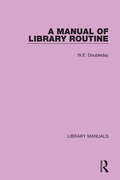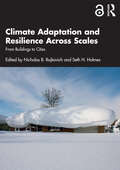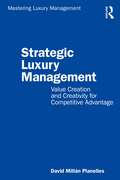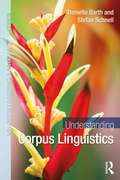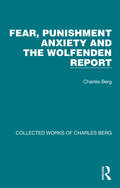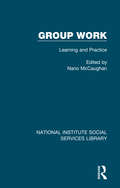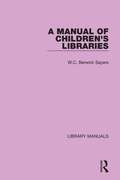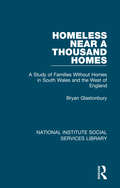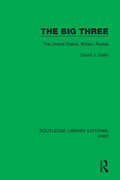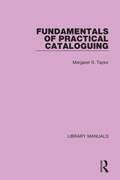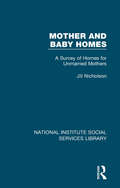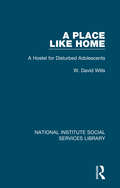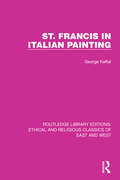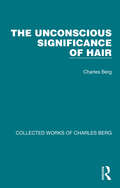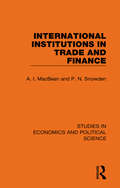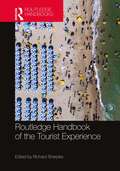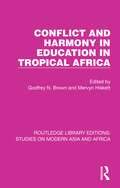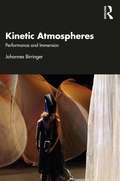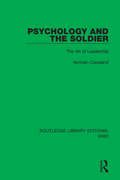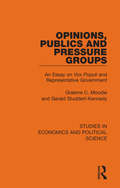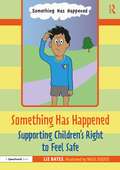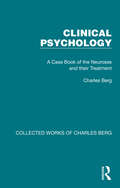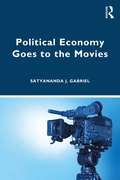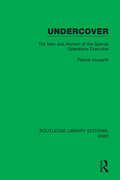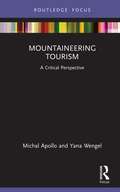Special Collections
Benetech’s Global Certified Accessible Titles
Description: Benetech’s GCA program is the first independent third-party EPUB certification to verify ebook accessibility. By creating content that is born accessible, publishers can meet the needs of all readers. Learn more: https://bornaccessible.benetech.org/
- Table View
- List View
A Manual of Library Routine
by W.E. DoubledayThis book, first published in 1933, addresses the ‘routine’ in library work: administration, organization, book selection and classification and cataloguing, as well as the office work, room supervision, shelf tidying and registration of borrowers, among others.
Climate Adaptation and Resilience Across Scales
by Nicholas B. RajkovichClimate Adaptation and Resilience Across Scales provides professionals with guidance on adapting the built environment to a changing climate. This edited volume brings together practitioners and researchers to discuss climate-related resilience from the building to the city scale. This book highlights North American cases that deal with issues such as climate projections, public health, adaptive capacity of vulnerable populations, and design interventions for floodplains, making the content applicable to many locations around the world. The contributors in this book discuss topics ranging from how built environment professionals respond to a changing climate, to how the building stock may need to adapt to climate change, to how resilience is currently being addressed in the design, construction, and operations communities. The purpose of this book is to provide a better understanding of climate change impacts, vulnerability, and resilience across scales of the built environment. Architects, urban designers, planners, landscape architects, and engineers will find this a useful resource for adapting buildings and cities to a changing climate.
Strategic Luxury Management
by David Millán PlanellesStrategic Luxury Management is a case-rich and practical overview of how luxury creates value and why some firms are more successful than others. The focus of luxury study has traditionally centered on the clients’ drivers of consumption, their perception of the brand and the way to effectively engage with them. Luxury is rarely, however, discussed from a strategic perspective: how luxury managers make complex decisions relative to their competitive environment. The book provides insight into the luxury industry and how companies face market complexity across three key areas. First, the company itself, determining what defines a luxury firm. Second, the book offers a specific framework to assess creativity across management and not simply as an individual talent. Third, the book considers the competitive landscape and the principles that allow companies to compete consistently and meaningfully. Each chapter includes pedagogical features to ensure comprehension, including chapter objectives and self-study questions. With examples and case studies from international firms illustrating each chapter, Strategic Luxury Management is essential reading for postgraduate, MBA and executive education students studying luxury management, luxury brand management, luxury creativity and innovation, and strategic management, as well as reflective practitioners within the luxury industry. Online resources include chapter-by-chapter PowerPoint slides.
Understanding Corpus Linguistics
by Danielle Barth and Stefan SchnellThis textbook introduces the fundamental concepts and methods of corpus linguistics for students approaching this topic for the first time, putting specific emphasis on the enormous linguistic diversity represented by approximately 7,000 human languages and broadening the scope of current concerns in general corpus linguistics. Including a basic toolkit to help the reader investigate language in different usage contexts, this book: Shows the relevance of corpora to a range of linguistic areas from phonology to sociolinguistics and discourse Covers recent developments in the application of corpus linguistics to the study of understudied languages and linguistic typology Features exercises, short problems, and questions Includes examples from real studies in over 15 languages plus multilingual corpora Providing the necessary corpus linguistics skills to critically evaluate and replicate studies, this book is essential reading for anyone studying corpus linguistics.
Fear, Punishment Anxiety and the Wolfenden Report
by Charles BergOriginally published in 1959, the blurb read: ‘Dr Berg has made a comprehensive survey of the Wolfenden Report in regard to homosexuality and illustrated his comments with extracts from case material. He points out that whereas public opinion has so far lagged behind the Committee’s main recommendation, scientifically far from being an advance the report may be considered lamentably reactionary. He says; "Perhaps this report is a good lesson in the futility of trying to unravel and assess psychological phenomena without first removing the obstacles to understanding their meaning". The author deals with the subject in his usual forthright, witty and persuasive style, which is easily enjoyed by psychiatrist and layman alike, and the book should be welcomed by all who seek to understand this controversial topic. Later chapters include a discussion of the wider implications of punishment and a new theory of the fundamental nature of Anxiety and Fear.’ Today it can be read and enjoyed in its historical context. This book is a re-issue originally published in 1959. The language used is a reflection of its era and no offence is meant by the Publishers to any reader by this re-publication.
Group Work
by Nano McCaughanGroup work is central to social work, whether it be work with individuals and families, residential care, community work, management or social work education. Despite, however, the upsurge of interest in this aspect of social work method at the time Group Work: Learning and Practice, originally published in 1978, represented the first attempt at providing an up-to-date and carefully integrated source book for students – in the form of a series of mainly original and British papers on social group work: its knowledge base; the possible varieties of practice settings and objectives; and its implications for social work education and training models. For new directions in social work education suggested that the small group was to become the core system around which much future social work teaching would be based. The main concern of this new National Institute for Social Work reader – the development and demonstration of intervention skills in practice – would be particularly relevant. The book draws attention to the opportunities for work with groups in the community, in residential institutions and with families, where the emphasis was rapidly shifting towards the need for greater understanding and use of the small group dimension. Group Work: Learning and Practice would have been widely welcomed both by specialists in group work at the time and all those more generally interested in social work methods – as teachers, students, practitioners, supervisors and as local authority training officers. It would also be of interest to a wider readership of teachers, youth workers and those concerned with the group dynamics and counselling fields.
A Manual of Children's Libraries
by W.C. Berwick SayersThis book, first published in 1932, is a guide to the details required of a successful children’s library, not just the books and catalogue, but also the different staffing needs of a collection aimed purely at children.
Homeless Near a Thousand Homes
by Bryan GlastonburyWho becomes homeless? Why? What stresses and strains do these people face? Does losing a home provoke other problems or is it a sequel to them? How far do government policies and provisions go towards meeting the needs of the homeless? What changes would be desirable? To what extent is homelessness due to housing shortages? Originally published in 1971, these and other questions are tackled in this study of the development of services for the homeless. It is based on detailed investigation of provisions in South Wales and the West Country and is a study of the lives of over 500 families who, at some stage since 1963, had lost their homes. Hitherto studies of homelessness had been restricted to London or other big urban centres. The questions posed and answered here are much more general, and relevant to all parts of the country at the time. Information for the survey came from the records kept in Local Authority Welfare, Children’s Health and Housing Departments, the Probation and After-Care Service, local offices of the Department of Health and Social Security, and many voluntary organizations. The findings suggest that, in the areas studied, homelessness was worse than anticipated, and that its demands on the social services were similar in range but different in order of priority from those in the metropolis. Poor housing conditions remain an important feature, reinforced by unhelpful attitudes in housing management. Housing shortages are important for large families and those who cannot be self-dependent – more so than for others. Looming over the whole picture is homelessness resulting from broken marriages and family disputes, with the attendant difficulties of unsupported motherhood, poverty, sickness and unemployment.
The Big Three
by David J. DallinThis book, first published in 1946, analyses the state of the world at the close of the Second World War. Global power was passing from Britain to the United States and the Soviet Union, with the US being involved in every part of the world, Russia dominant in eastern Europe and the world looked a very uncertain place. This survey of the main three powers examines their changing conditions and foreign policies.
Fundamentals of Practical Cataloguing
by Margaret S. TaylorThis book, first published in 1948, lays out the basic precepts for the useful cataloguing of a library’s collection. With catalogues being first compiled to serve as records of stock – a practice dating back to ancient Egypt – modern developments have updated the methods for doing so, for instance adding a bibliographic description to the record.
Mother and Baby Homes
by Jill NicholsonDuring the 1960s there had been much discussion about the plight of the unmarried mother and her child; but very little of it had been based on fact. At the time Mother and Baby Homes catered for between 11,000 and 12,000 unmarried mothers each year, out of a total of 70,000; but there was hardly one generalisation that would be applicable to all the Homes. Some were run by voluntary organisations, some by local authorities and some by religious groups. While some still retained the punitive attitude, others set themselves with much kindness to help the women – some of them mere schoolgirls, to face the difficulties of their position and to plan constructively for their own future and that of their babies. Originally published in 1968, this book gives the facts but, even more, it gives the feelings and ideas of those most concerned – the mothers-to-be and those who care for them. This is a careful and sensitive study. It was unique in putting on record for the first time the views of unmarried mothers themselves about the care they received. Everybody who is interested in the history of the health and welfare of the unmarried mother in residential care should read this book.
A Place Like Home
by W. David WillsThe late David Wills spent a lifetime in the service of the so-called delinquent, the misfit, the maladjusted. He was the first Englishman to train as a psychiatric social worker and was well known for his books The Hawkspur Experiment, The Barns Experiment, etc. Originally published in 1970, this book describes another experiment with a hostel for boys leaving schools for maladjusted children and lacking any settled home from which to enter the community. It demonstrates once again David Wills’s conviction that the offender wants to be ‘good’ and will be helped by affection rather than by punishment. Yet it is obvious that the work was full of stress and that only people with some of the attributes of archangels could respond to the boys’ needs and remain in control of the situation. The book demonstrates the extent of deprivation suffered by such young people and that no ordinary hostels or lodgings will do if they are to be set upon a less turbulent course of life, leading to truly adult independence. It added greatly to our understanding of the personalities, experience of life and needs of maladjusted boys in their ‘teens at the time, although the lessons drawn from it were disturbing in relation both to prevention and treatment. The penetration of David Wills’s assessment is beyond doubt and (as Dame Eileen Younghusband concludes in her Foreword) his book will give a great deal to those ‘trying in various capacities to help boys and girls who otherwise would grow into adulthood permanently handicapped emotionally and socially’. This book is a re-issue originally published in 1970. The language used is a reflection of its era and no offence is meant by the Publishers to any reader by this re-publication.
St. Francis in Italian Painting
by George KaftalOriginally published in 1950, this book shows that the religious and ethical values that St. Francis was striving after are as essential today as they were in his time. The book presents St. Francis as a complex personality and corrects the rather mawkish interpretation of certain legends. It deals with the environment and development of the saint’s personality and chapters from his biographies by Thomas of Celano or St. Bonaventure and many black and white plates illustrating them which are reproductions of paintings by Italian masters from the XIIIth to the late XVth century.
The Unconscious Significance of Hair
by Charles BergOriginally published in 1951, the implications of this book were thought to be far wider and deeper than its title suggests. 'Hair-activities are chosen merely as a sample of uncritically accepted human behaviour. The author then proceeds to examine them very carefully in the light of dreams, anthropology, folklore, symptoms and perversions. He shows them to be an expression of instinct-driven tensions and conflicts. The popular illusion that they are determined by reason or adaption to reality is exploded. The corollary is inescapable; if in this innocent particular our thoughts and behaviour are symptomatic expressions of an unconscious conflict or complex, how much more psychopathic would our more significant ideas, beliefs, institutions, customs and laws prove to be on similar detailed investigation! Is, therefore, our self-expression in life and civilization nothing more than a symptom, identical in its source and mechanism with the symptoms of nervous and mental illness? The book is really a psychiatric criticism of normality based upon a chosen item of typically normal behaviour. It is, however, written in a way that will be easily understood by every intelligent reader.' This book is a re-issue originally published in 1951. The language used is a reflection of its era and no offence is meant by the Publishers to any reader by this re-publication.
International Institutions in Trade and Finance
by A. I. MacBean and P. N. SnowdenOriginally published in 1981, this book provided an up-to-date and critical review of the recent history and current status of the main economic institutions affecting international trade and relations at the time. The authors emphasise the economic effectiveness or otherwise of such bodies as GATT, IMF, EEC, UNCTAD and the World Bank, but take account of the political factors present in both the initial ‘design’ and in the way that the institutions have developed. In particular, the book analyses the changed degree of dominance which the USA had been able to exert on the international community.
Routledge Handbook of the Tourist Experience
by Richard SharpleyRoutledge Handbook of the Tourist Experience offers a comprehensive synthesis of contemporary research on the tourist experience. It draws together multidisciplinary perspectives from leading tourism scholars to explore emergent tourist behaviours and motivations. This handbook provides up-to-date, critical discussions of established and emergent themes and issues related to the tourist experience from a primarily socio-cultural perspective. It opens with a detailed introduction which lays down the framework used to examine the dynamic parameters of the tourist experience. Organised into five thematic sections, chapters seek to build and enhance knowledge and understanding of the significance and meaning of diverse elements of the tourist experience. Section 1 conceptualises and understands the tourist experience through an exploration of conventional themes such as tourism as authentic and spiritual experience, as well as emerging themes such as tourism as an embodied experience. Section 2 investigates the new, developing tourist demands and motivations, and a growing interest in the travel career. Section 3 considers the significance, motives, practices and experiences of different types of tourists and their roles such as the tourist as photographer. Section 4 discusses the relevance of ‘place’ to the tourist experience by exploring the relationship between tourism and place. The last section, Section 5, scrutinises the role of the tourist in creating their experiences through themes such as ‘transformations in the tourist role’ from passive receiver of experiences to co-creator of experiences, and ‘external mediators in creating tourist experiences'. This handbook is the first to fill a notable gap in the tourism literature and collate within a single volume critical insights into the diverse elements of the tourist experience today. It will be of key interest to academics and students across the fields of tourism, hospitality management, geography, marketing and consumer behaviour.
Conflict and Harmony in Education in Tropical Africa
by Godfrey N. Brown and Mervyn HiskettOriginally published in 1975, this book was something of a pioneering study. It examines the three main traditions of African educational development – indigenous, Islamic and ‘Western’ – and the resulting harmonies and conflicts that arise from these traditions. Its contributors are all specialists writing about their own particular area of interest covering many countries of tropical Africa. They include a number of well-known African scholars as well as some comparatively new names in the field of African Studies at the time. A feature of the book is the attention that it gives to the education of women – an aspect of ‘nation-building’ that had often been rather neglected. This study is an inter-disciplinary work, calling into contribution History, Sociology, Anthropology, Law, Linguistics, and Medicine, as well as Education. It seeks to show how complex the educational situation is in Africa – and how this complexity needs to be appreciated as a background to educational planning. Nobody who has read this volume will be inclined to dismiss educational reform in Africa as ‘a relatively simple matter’ – a point of view too frequently implied by those who have not studied the subject in depth. ‘Off with the old – on with the new’ cannot be so easily implemented as critics within and without the continent sometimes seem to think. More constructively, however, this volume provides many useful insights into ways in which social tension may be reduced and harmony promoted in, and through, education. Although it is likely to be of most immediate value to those who are concerned with African education and its administration (especially in teacher-education), the book constitutes a significant contribution to understanding problems of ‘development’.
Kinetic Atmospheres
by Johannes BirringerThis book offers a sustained and deeply experiential pragmatic study of performance environments, here defined at unstable, emerging, and multisensational atmospheres, open to interactions and travels in augmented virtualities. Birringer’s writings challenge common assumptions about embodiment and the digital, exploring and refining artistic research into physical movement behavior, gesture, sensing perception, cognition, and trans-sensory hallucination. If landscapes are autobiographical, and atmospheres prompt us to enter blurred lines of a "forest knowledge," where light, shade, and darkness entangle us in foraging mediations of contaminated diversity, then such sensitization to elemental environments requires a focus on processual interaction. Provocative chapters probe various types of performance scenarios and immersive architectures of the real and the virtual. They break new ground in analyzing an extended choreographic – the building of hypersensorial scenographies that include a range of materialities as well as bodily and metabodily presences. Foregrounding his notion of kinetic atmospheres, the author intimates a technosomatic theory of dance, performance, and ritual processes, while engaging in a vivid cross-cultural dialogue with some of the leading digital and theatrical artists worldwide. This poetic meditation will be of great interest to students and scholars in theatre, performing arts as well as media arts practitioners, composers, programmers, and designers.
Psychology and the Soldier
by Norman CopelandThis book, first published in 1944, stresses the point that there is no shortcut to successful wartime leadership, and pays a close analysis to the attributes that contribute to being a sound leader of soldiers. Written in the middle of the Second World War, this book gives us valuable insights into the values and training of the British Army in the second half of the war.
Opinions, Publics and Pressure Groups
by Gerald Studdert-Kennedy and Graeme C. MoodieIn the late 1960s representative democracy was under fire from various directions even in countries, like Britain and America, where it had appeared to be most secure and successful. Must democracy be a sham, either because of the power of pressure groups and other established decision-makers, or because ‘the people’ are too ignorant and irrational? What, in any case, does or can representative government mean in a complex industrial society – and what does it mean to be rational in politics? It is to these and other vital issues that this book, originally published in 1970, directs itself. In the course of their argument the authors, who feel no contradiction between their academic and their ‘radical democratic’ commitments, draw extensively upon recent empirical studies of voting, pressure groups, and of the sociological and social psychological aspects of political behaviour in Britain and the USA at the time. Problems of the nature of such evidence, the conduct of attitude surveys and opinion polls, and the relationship between modern research and the traditional themes of political theory are also analysed.
Something Has Happened: Supporting Children’s Right to Feel Safe
by Liz BatesFor effective use, this book should be purchased alongside the guidebook. Both books can be purchased together as a set, Something Has Happened: A Storybook and Guide for Safeguarding and Supporting Children’s Right to Feel Safe [978-1-032-06912-8] Something has happened to Joe. Now he doesn’t feel safe; he feels sick, wants to cry and can’t even concentrate on his computer games. This carefully and sensitively written storybook has been created to enable conversations around safeguarding, teaching children about their right to feel safe, and what to do if, like Joe, they ever need help. With colourful and engaging illustrations, the story offers opportunities for discussion throughout, using Joe as a tool to help children understand their difficult feelings, who they can go to for help, and what they can do when it feels like nobody is listening. This storybook: Teaches children about the right to feel safe, the safety continuum, networks of support and persistence Offers advice that can be used by children in any situation, from disclosing abuse to talking about smaller worries Can be used with both primary and lower-secondary aged pupils as a whole class, in small groups or in one-to-one sessions Designed to be used alongside the professional guidebook, A Practical Resource for Supporting Children’s Right to Feel Safe, this is an essential tool for teachers, support staff and other professionals who want to teach children that being safe from harm is the most important right they have, and that the trusted adults around them will always take action to believe and protect them.
Clinical Psychology
by Charles BergOriginally published in 1948 the blurb read: 'Dr Berg has an extraordinary flair for presenting a difficult subject in a most realistic and attractive manner, without sacrifice of scientific essentials. The patients are made to speak for themselves, with the result that we feel actually present at the analytical sessions, sharing the most intimate details of each individual’s life and feelings. Throughout it is alive with real, vivid clinical material. The reader is led through a panorama of troubled minds and disturbed emotions – from the simplest worries and anxieties, through increasing severity of stresses, to incipient major disorders. The whole subject of treatment is reviewed and expounded in compendious detail, concluding with a critical review and revolutionary suggestions for the future. In spite of its novel and entertaining method of exposition, the book covers a surprisingly wide field – the whole field of clinical psychology up to date – and more.' Today it can be read and enjoyed in its historical context. This book is a re-issue originally published in 1948. The language used is a reflection of its era and no offence is meant by the Publishers to any reader by this re-publication.
Political Economy Goes to the Movies
by Satyananda J. GabrielPolitical Economy Goes to the Movies provides an introduction to political economy using a wide range of popular films and documentaries as the objects of analysis. The work helps readers to understand and analyze the economic and related political, cultural, and ecological relationships depicted in selected films. This is achieved through the lens of past and present economic theories and in the context of debates over the dynamic influence of economics on individual life chances. Film may have more to teach us about the real world than the abstractions of certain economic theories. A world of income inequality, child labor in mills and mines, local rebellions against land seizures, and wars triggered by economic conflicts provide the context for many films mirroring real world events. Some films depict the interacting and intersecting political, economic, cultural, and ecological contexts within and between variant economic relationships, whereas other films show “catastrophes” such as economic depressions, disruptive social transitions, violent revolutions, and existential environmental degradation – a world in disequilibrium. Films allow us to see a panoply of human social relationships and related problems, even to explore cataclysmic moments in our species life, but not to necessarily see the why of these relationships and problems. Simultaneously, mainstream economics has severe constraints on what can be analyzed. Film exposes this weakness of the mainstream model. Twelve Years a Slave, Trumbo, The Big Short and others are analyzed for their realism by referencing documented historical social events, and behavioral economics provides further data for analyzing the realism of social interaction within the films. Exploring events and contexts absent from the typical economics text or the basic level economics classes, this work is essential reading for students and scholars of political economy in both economics and politics departments, as well as those of pluralist economics and Marxist economics.
Undercover
by Patrick HowarthThis book, first published in 1980, is an invaluable assessment of SOE’s contribution to the Allied victory. From both first-hand knowledge (Howarth served with SOE for 4 years) and in-depth research, this book traces the development of the organisation and its successes and failures. By bringing to life some of the outstanding men and women who served in SOE, this book pays tribute to their bravery and examines their role in fomenting and supporting clandestine resistance against the Nazi regime.
Mountaineering Tourism
by Michal Apollo and Yana WengelThis book offers a critical account of the historical evolution of mountaineering and its relation to the phenomenon of tourism, providing an overview of recent developments linked to the diversification, commodification and commercialisation of mountaineering activity. Mountaineering, broadly defined as hiking, trekking and climbing, is now a mass phenomenon, with continually growing numbers of trekkers, climbers and religious tourists hiking in mountain regions. Increasing visitor numbers require the current policies to be updated. The environments around high-mountain areas and their local resident communities, until recently cut off from civilisation, are sensitive to outside influences and have been abruptly exposed to the impact of mountaineering and related activities. This is the first book to disentangle overlapping terms and definitions related to mountaineering tourism. It identifies the key terms and turning points in mountaineering tourism and discusses the impacts of mountaineering tourism from an environmental, socio-cultural and personal perspective and identifies current tourism management policies. Finally, this book provides a continuum between the past and future of mountaineering tourism and aims to provide policy suggestions for sustainable management of fragile mountain regions. This will be of great interest to upper-level students and academics of tourism, as well as industry representatives and policymakers with an interest in adventure tourism and mountaineering.
